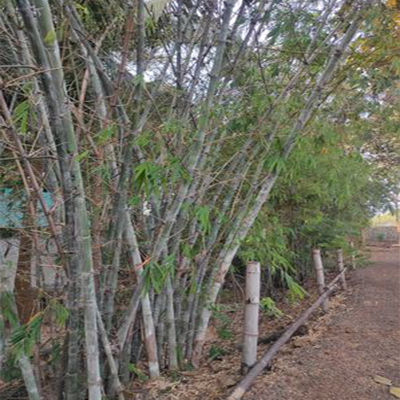14. Dendrocalamus membranaceus Munro, Trans
Local names
Waya Bamboo, White Bamboo
General description
Dendrocalamus membranaceus is a moderate-sized, strong bamboo forming loose clump. Woody stems 20 - 24 metres tall growing from short rhizomes. The stems can be 6 - 10cm in diameter with internodes 22 - 42cm long. Culm-sheaths 30-50 cm long and 12-20 cm broad. Leaves 12-25 cm long and 1.5-2.5 cm broad, hairy on the midrib beneath. Inflorescence a large compound panicle with distant globular heads. Spikelets slightly compressed, glossy, nearly glabrous, 10-13 mm long and 2.5 mm broad, with 2 to 3 fertile flowers. Stamens exserted; filaments long, fine; anthers yellow, shortly apiculate. Ovary ovoid, hairy above, glabrous below, ovate, produced into a long hairy style, ending in a purple plumose stigma. Caryopsis broadly ovate, rounded at base, 5-7.5 mm long, grooved on one side and somewhat flattened. Flowering has been reported in this species in 1973, 1992 and 1994 from North-Eastern India.
Habit and Habitat
Tree form. An undergrowth plant in dry/moist tropical and subtropical broadleaf forests, montane rain forest and semi-evergreen rain forest at elevations up to 3,000 metres. This is one of the common species occurring in China and Taiwan. It occurs in moist forests and low lands and is found below 1000 m altitude. Also tolerates arid and barren condition. Preferred soils are laterite and black limestone.
Distribution
China, Bangladesh, Myanmar, Thailand, Cambodia, Laos, Vietnam and Taiwan.
Uses
Used for building purposes in Myanmar and Thailand. Most promising species for pulp. Young shoots are edible. In China, it is used for making chopsticks, shreds and paper.



